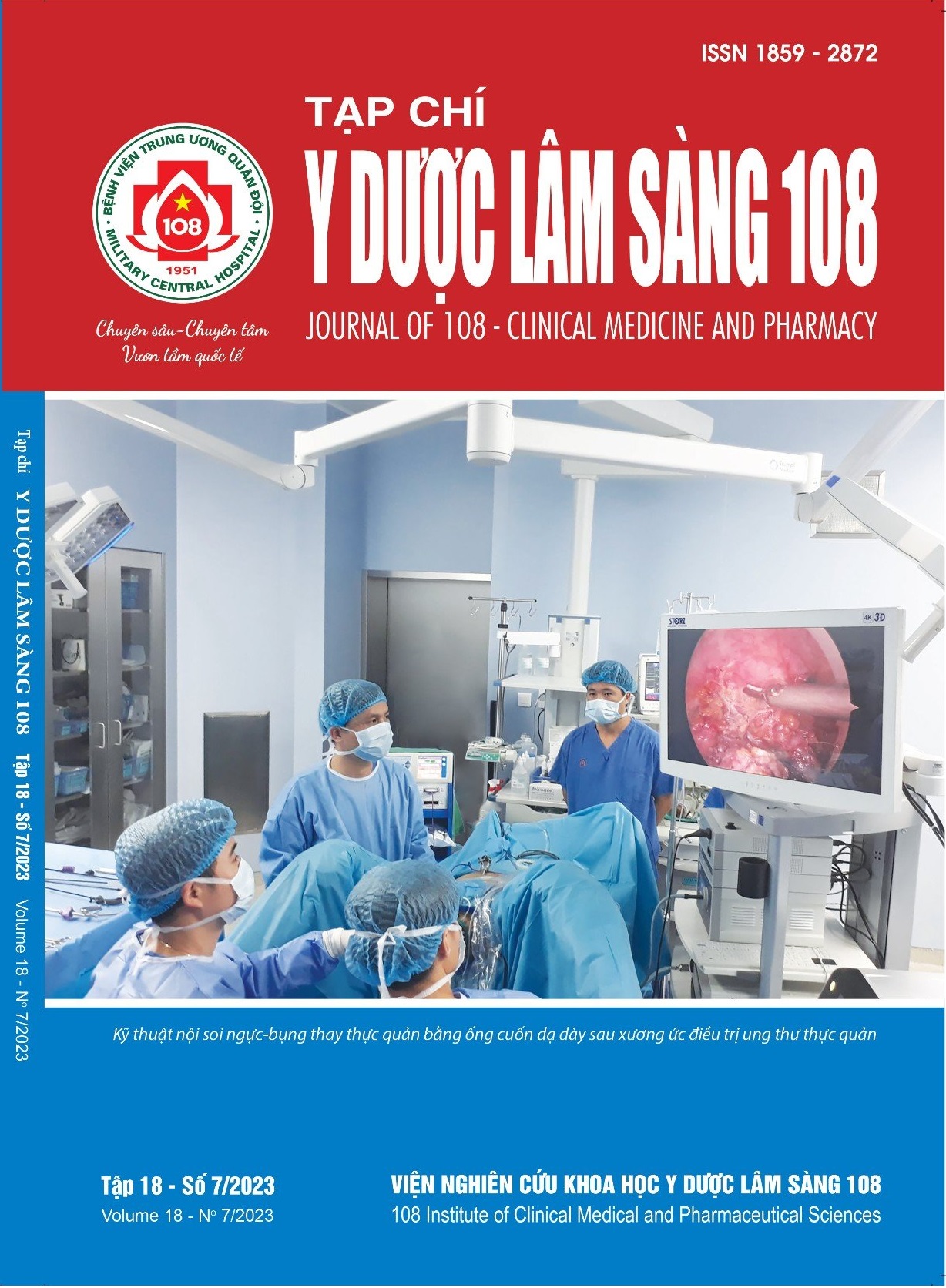Research on clinical and paraclinical characteristics in patients with biliary tract stones at 108 Military Central Hospital
Main Article Content
Keywords
Abstract
Objective: To evaluate the clinical and paraclinical features of patients with gallstones (cholelithiasis). Subject and method: A combined retrospective and prospective study was conducted on 1,163 patients with 1,383 admissions at 108 Military Central Hospital from January 2021 to December 2022, assessing the treatment history, clinical characteristics, and paraclinical indicators. Result: Among the study population, 55.9% of patients had no history of surgical treatment or interventional treatment. The median age of patients was 62 years, with 60.4% of patients being over 60 years old. The male-to-female ratio was approximately equal. The main clinical symptoms were abdominal pain (84.2%), fever (47.7%), and jaundice (39.8%). Within the study population, 6.9% experienced hypotension, and 1.6% had consciousness disorders. Blood culture was performed on 15.8% of patients, with a positive rate of 50.5%. Imaging diagnosis revealed bile duct dilation in 80.7% of cases. The median size of common bile duct stones was 14mm, detected in 64.9% of patients, mostly with a quantity of less than 3 stones. In contrast, intrahepatic bile duct stones had a median size of 15mm, detected in 41.6% of cases, predominantly with multiple stones. Dangerous complications of gallstones included septic shock, septicemia, and severe cholangitis, observed in 7.7%, 8%, and 18.1% of cases, respectively. Pancreatitis occurred in 9.1% of patients. Conclusion: Gallstone disease is a common condition, particularly among elderly patients, and is associated with various dangerous complications. Recognizing and diagnosing the common clinical and paraclinical symptoms helps in early detection and diagnosis of the disease, thereby reducing the risk of severe complications.
Article Details
References
2. Tazuma S (2006) Gallstone disease: Epidemiology, pathogenesis, and classification of biliary stones (common bile duct and intrahepatic). Best Pract Res Clin Gastroenterol 20(6): 1075-1083.
3. Văn Tần, Nguyễn Cao Cương, Trần Thiện Hoà (2006) Tần suất mắc sỏi mật ở người trên 50 tuổi tại TP. Hồ Chí Minh. Tạp chí Y học Việt Nam, 329, tr. 302-312.
4. Lê Văn Nghĩa, Đỗ Văn Dũng, Văn Tần (1999) Điều tra xác định số đo hiện mắc sỏi mật tại Thành phố Hồ Chí Minh. Báo cáo khoa học tại Đại hội Ngoại khoa Việt Nam lần thứ X, tr. 155-166.
5. Ahmed M (2018) Acute cholangitis-an update. World J Gastrointest Pathophysiol 9(1): 1-7.
6. Kiriyama S, Kozaka K, Takada T, Strasberg SM, Pitt HA, Gabata T, Hata J, Liau KH, Miura F, Horiguchi A, Liu KH, Su CH, Wada K, Jagannath P, Itoi T, Gouma DJ, Mori Y, Mukai S, Giménez ME, Huang WS, Kim MH, Okamoto K, Belli G, Dervenis C, Chan ACW, Lau WY, Endo I, Gomi H, Yoshida M, Mayumi T, Baron TH, de Santibañes E, Teoh AYB, Hwang TL, Ker CG, Chen MF, Han HS, Yoon YS, Choi IS, Yoon DS, Higuchi R, Kitano S, Inomata M, Deziel DJ, Jonas E, Hirata K, Sumiyama Y, Inui K, Yamamoto M (2018) Tokyo Guidelines 2018: diagnostic criteria and severity grading of acute cholangitis (with videos). J Hepatobiliary Pancreat Sci 25(1): 17-30.
7. Shaffer EA (2005) Epidemiology and risk factors for gallstone disease: Has the paradigm changed in the 21st century? Curr Gastroenterol Rep 7(2): 132-140.
8. Nguyễn Công Long, Lục Lê Long (2022) Đánh giá kết quả phương pháp nội soi mật tụy ngược dòng ở bệnh nhân sỏi ống mật chủ tại Bệnh viện Bạch Mai. Tạp chí Y học Việt Nam, 513, tr. 62-65.
9. Nguyễn Anh Tân, Dương Hồng Thái (2022) Kết quả điều trị sỏi ống mật chủ bằng kỹ thuật nội soi mật tụy ngược dòng tại Bệnh viện đa khoa tỉnh Bắc Ninh. Tạp chí Y học Việt Nam, 511(2), tr. 62-65.
10. Dương Minh Thắng, Phạm Minh Ngọc Quang, and Vũ Thị Phượng (2019) Kết quả nội soi mật tụy ngược dòng cấp cứu điều trị viêm đường mật và viêm tụy cấp thể phù nề do sỏi ống mật chủ. Tạp chí Y dược lâm sàng 108, 14(7), tr. 7-12.
11. Dương Xuân Nhương (2019) Nghiên cứu đặc điểm lâm sàng và cận lâm sàng và kết quả điều trị sỏi ống mật chủ ở người cao tuổi bằng NSMTND. Học viện Quân Y.
12. Vũ Việt Đức, Lê Văn Thành, Trần Đức Quý (2021) Đánh giá kết quả điều trị sỏi đường mật trong gan bằng phẫu thuật nội soi và sử dụng ống soi mềm tán thủy lực qua ống nối mật da tại Bệnh viện Trung ương Quân đội 108. Tạp chí Y học Việt Nam, 498, tr. 62-65.
13. Nguyễn Công Long, Nguyễn Thị Dân (2022) Nhận xét đặc điểm lâm sàng, cận lâm sàng bệnh nhân sỏi ống mật chủ có túi thừa tá tràng và không có túi thừa tá tràng. Tạp chí Y học Việt Nam, 510, tr. 62-65.
 ISSN: 1859 - 2872
ISSN: 1859 - 2872
